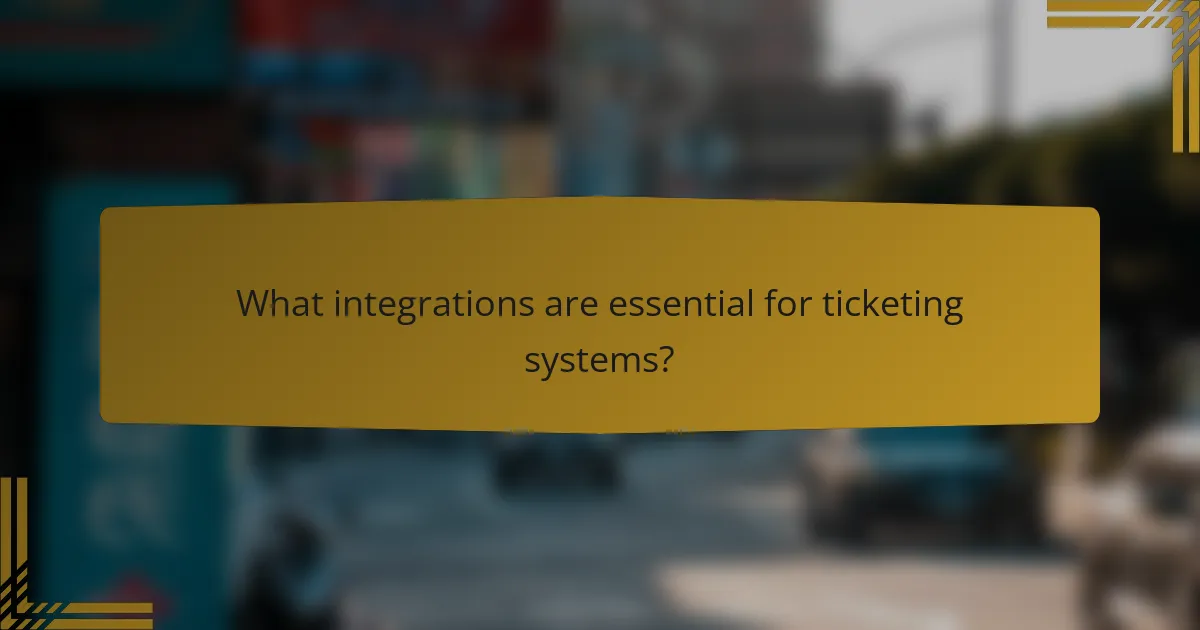Implementing a ticketing system is crucial for businesses aiming to enhance customer support and operational efficiency. By selecting the right software and focusing on user experience, organizations can effectively manage inquiries and streamline communication. This not only leads to faster resolution times but also improves overall customer satisfaction.

How to implement a ticketing system in the UK?
Implementing a ticketing system in the UK involves selecting the right software, configuring it to meet your business needs, and training your team. Focus on user experience and integration with existing tools to ensure efficiency and satisfaction.
Step-by-step implementation guide
Start by defining your requirements, including the types of tickets you will manage and the features needed, such as automation and reporting. Next, research and choose a ticketing system that fits your criteria, considering options like Zendesk, Freshdesk, or Jira Service Management.
Once you’ve selected a system, configure it according to your needs, setting up categories, workflows, and user roles. After configuration, conduct thorough testing to identify any issues before going live. Finally, roll out the system and monitor its performance, making adjustments as necessary.
Best practices for UK businesses
To maximize the effectiveness of your ticketing system, ensure it is user-friendly and accessible. Provide comprehensive training for your staff to help them navigate the system efficiently and encourage them to utilize all available features.
Regularly review ticketing metrics to identify trends and areas for improvement. Implement feedback loops with users to continually refine the process. Additionally, consider compliance with UK data protection regulations, such as the GDPR, to safeguard customer information.

What are the benefits of using a ticketing system?
A ticketing system streamlines the process of managing customer inquiries and issues, leading to improved organization and faster resolution times. By centralizing communication and tracking requests, businesses can enhance both operational efficiency and customer satisfaction.
Improved efficiency
Implementing a ticketing system significantly boosts operational efficiency by automating workflows and reducing manual tasks. For instance, automated ticket assignment ensures that inquiries reach the appropriate team members without delay, which can cut response times by a notable margin.
Additionally, ticketing systems often provide analytics and reporting features that help identify bottlenecks in service delivery. By analyzing data, organizations can make informed decisions to optimize processes, allocate resources effectively, and ultimately enhance productivity.
Enhanced user experience
A ticketing system enhances user experience by providing customers with a clear channel for support and updates on their inquiries. Customers appreciate the ability to track the status of their tickets, which fosters transparency and trust in the service process.
Moreover, many ticketing systems offer self-service options, allowing users to find answers to common questions without needing direct assistance. This not only improves satisfaction but also reduces the volume of incoming requests, allowing support teams to focus on more complex issues.

Which ticketing systems are popular in the UK?
In the UK, several ticketing systems stand out for their effectiveness and user experience. Notable options include Zendesk, Freshdesk, and Jira Service Management, each offering unique features tailored to different business needs.
Zendesk
Zendesk is a widely used ticketing system known for its user-friendly interface and robust functionality. It allows businesses to manage customer inquiries efficiently through various channels, including email, chat, and social media.
Key features include automation tools, reporting capabilities, and a customizable dashboard. Companies often appreciate its scalability, making it suitable for both small businesses and large enterprises.
When implementing Zendesk, ensure you take advantage of its integration options with other software, which can enhance your overall customer support strategy.
Freshdesk
Freshdesk is another popular ticketing system that emphasizes ease of use and affordability. It offers a range of features such as ticket management, team collaboration tools, and a knowledge base for self-service support.
This system is particularly appealing to startups and small businesses due to its competitive pricing and free tier options. Freshdesk also supports multi-channel communication, allowing customers to reach out via email, phone, or social media.
To maximize Freshdesk’s potential, consider utilizing its automation features to streamline repetitive tasks and improve response times.
Jira Service Management
Jira Service Management is tailored for IT service management and is part of the broader Jira ecosystem. It provides powerful ticketing capabilities along with project management tools, making it ideal for tech-focused organizations.
Its strengths lie in workflow customization and integration with development tools, which can enhance collaboration between IT and other departments. Companies often use it to manage incidents, service requests, and changes effectively.
When adopting Jira Service Management, focus on configuring workflows that align with your team’s processes to ensure smooth operations and better service delivery.

How to choose the right ticketing system?
Choosing the right ticketing system involves assessing your specific needs, budget, and the features that will enhance user experience. A well-selected system can streamline operations, improve customer satisfaction, and increase efficiency.
Criteria for selection
When selecting a ticketing system, consider factors such as scalability, ease of use, integration capabilities, and customer support. A system should be able to grow with your organization and adapt to changing needs without excessive complexity.
Evaluate the user interface to ensure it is intuitive for both staff and customers. Look for systems that offer customizable features, allowing you to tailor the ticketing process to your unique requirements.
Additionally, check for reporting and analytics capabilities, which can provide insights into ticket sales, customer behavior, and operational efficiency. This data can help you make informed decisions and optimize your service delivery.
Cost considerations
Cost is a critical factor when choosing a ticketing system, as prices can vary widely based on features and service levels. Expect to see options ranging from subscription-based models to one-time purchase fees, with monthly costs typically falling between $50 to several hundred dollars depending on the complexity.
Be mindful of additional costs such as transaction fees, setup fees, and ongoing maintenance. Some systems may offer lower upfront costs but could have higher long-term expenses due to these additional charges.
Finally, consider the potential return on investment. A more expensive system that significantly enhances efficiency and user experience may ultimately save money in the long run through increased sales and reduced operational costs.

What integrations are essential for ticketing systems?
Essential integrations for ticketing systems include Customer Relationship Management (CRM) tools and communication platforms. These integrations enhance user experience, streamline operations, and improve customer support efficiency.
CRM integrations
Integrating a ticketing system with a CRM allows for seamless data sharing between customer support and sales teams. This connection helps track customer interactions, preferences, and history, enabling personalized service and faster resolution times.
When selecting a CRM integration, consider compatibility with your existing systems and the ability to automate ticket creation from customer inquiries. Popular CRM systems like Salesforce and HubSpot offer robust APIs that facilitate these integrations.
Communication tools
Communication tool integrations, such as email, chat, and social media platforms, are vital for a responsive ticketing system. They enable support teams to manage inquiries from various channels in one place, ensuring no customer request is overlooked.
Look for integrations that allow for real-time notifications and updates. Tools like Slack or Microsoft Teams can enhance collaboration among support staff, while platforms like Zendesk or Freshdesk can centralize communication and ticket management effectively.

How to measure the efficiency of a ticketing system?
Measuring the efficiency of a ticketing system involves evaluating its performance through various metrics that reflect responsiveness and user satisfaction. Key aspects include response times, resolution rates, and user feedback, which together provide a comprehensive view of how well the system is functioning.
Key performance indicators
Key performance indicators (KPIs) are essential for assessing the efficiency of a ticketing system. Common KPIs include average response time, average resolution time, ticket backlog, and customer satisfaction scores. For instance, a desirable average response time might be within a few hours, while resolution times should ideally be within a day for most issues.
When selecting KPIs, consider aligning them with your organization’s goals. For example, if customer satisfaction is a priority, focus on metrics that directly reflect user experience, such as Net Promoter Score (NPS) or customer satisfaction ratings. Regularly reviewing these KPIs helps identify trends and areas for improvement.
Reporting tools
Effective reporting tools are crucial for tracking the performance of a ticketing system. These tools can generate detailed reports on KPIs, allowing teams to visualize data trends and make informed decisions. Popular options include software like Zendesk, Freshdesk, and Jira, which offer built-in analytics features.
When choosing a reporting tool, consider its integration capabilities with your existing systems and the level of customization it offers. Look for features such as real-time dashboards, automated reporting, and the ability to filter data by various parameters. This will enable your team to quickly identify inefficiencies and enhance overall ticketing system performance.
